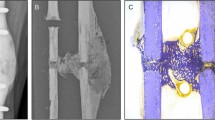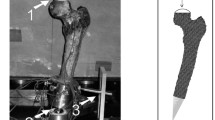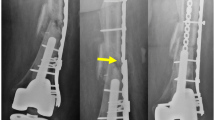Abstract
Approximately 6 million fractures occur each year in the United States, with an estimated medical and loss of productivity cost of $99 billion. As our population ages, it can only be expected that these numbers will continue to rise. While there have been recent advances in available treatments for fractures, assessment of the healing process remains a subjective process. This study aims to demonstrate the use of micro-computed tomography (μCT)-based structural rigidity analysis to accurately and quantitatively assess the progression of fracture healing over time in a rat model. The femora of rats with simulated lytic defects were injected with human BMP-2 cDNA at various time points postinjury (t = 0, 1, 5, 10 days) to accelerate fracture healing, harvested 56 days from time of injury, and subjected to μCT imaging to obtain cross-sectional data that were used to compute torsional rigidity. The specimens then underwent torsional testing to failure using a previously described pure torsional testing system. Strong correlations were found between measured torsional rigidity and computed torsional rigidity as calculated from both average (R 2 = 0.63) and minimum (R 2 = 0.81) structural rigidity data. While both methods were well correlated across the entire data range, minimum torsional rigidity was a better descriptor of bone strength, as seen by a higher Pearson coefficient and smaller y-intercept. These findings suggest considerable promise in the use of structural rigidity analysis of μCT data to accurately and quantitatively measure fracture-healing progression.




Similar content being viewed by others
References
Morshed S, Corrales L, Genant H, Miclau T 3rd (2008) Outcome assessment in clinical trials of fracture-healing. J Bone Joint Surg Am 90(Suppl 1):62–67
Finkelstein EA, Corso PS, Miller TR (2006) The incidence and economic burden of injuries in the United States. Oxford University Press, New York
Barrett JA, Baron JA, Karagas MR, Beach ML (1999) Fracture risk in the U.S. Medicare population. J Clin Epidemiol 52:243–249
Centers for Disease Control, Prevention (1996) Incidence and costs to Medicare of fractures among Medicare beneficiaries aged ≥65 years—United States, July 1991–June 1992. MMWR Morb Mortal Wkly Rep 45:877–883
Betz OB, Betz VM, Nazarian A, Pilapil CG, Vrahas MS, Bouxsein ML, Gerstenfeld LC, Einhorn TA, Evans CH (2006) Direct percutaneous gene delivery to enhance healing of segmental bone defects. J Bone Joint Surg Am 88:355–365
Firoozabadi R, Morshed S, Engelke K, Prevrhal S, Fierlinger A, Miclau T III, Genant HK (2008) Qualitative and quantitative assessment of bone fragility and fracture healing using conventional radiography and advanced imaging technologies—focus on wrist fracture. J Orthop Trauma 22:S83–S90
Matsuyama J, Ohnishi I, Sakai R, Bessho M, Matsumoto T, Miyasaka K, Harada A, Ohashi S, Nakamura K (2008) A new method for evaluation of fracture healing by echo tracking. Ultrasound Med Biol 34:775–783
Duvall CL, Taylor WR, Weiss D, Wojtowicz AM, Guldberg RE (2007) Impaired angiogenesis, early callus formation, and late stage remodeling in fracture healing of osteopontin-deficient mice. J Bone Miner Res 22:286–297
Schmidhammer R, Zandieh S, Mittermayr R, Pelinka LE, Leixnering M, Hopf R, Kroepfl A, Redl H (2006) Assessment of bone union/nonunion in an experimental model using microcomputed technology. J Trauma 61:199–205
Shefelbine SJ, Simon U, Claes L, Gold A, Gabet Y, Bab I, Muller R, Augat P (2005) Prediction of fracture callus mechanical properties using micro-CT images and voxel-based finite element analysis. Bone 36:480–488
Nyman JS, Munoz S, Jadhav S, Mansour A, Yoshii T, Mundy GR, Gutierrez GE (2009) Quantitative measures of femoral fracture repair in rats derived by micro-computed tomography. J Biomech 42:891–897
Morgan EF, Mason ZD, Chien KB, Pfeiffer AJ, Barnes GL, Einhorn TA, Gerstenfeld LC (2009) Micro-computed tomography assessment of fracture healing: relationships among callus structure, composition, and mechanical function. Bone 44:335–344
Hong J, Cabe GD, Tedrow JR, Hipp JA, Snyder BD (2004) Failure of trabecular bone with simulated lytic defects can be predicted non-invasively by structural analysis. J Orthop Res 22:479–486
Snyder BD, Cordio MA, Nazarian A, Kwak SD, Chang DJ, Entezari V, Zurakowski D, Parker LM (2009) Noninvasive prediction of fracture risk in patients with metastatic cancer to the spine. Clin Cancer Res 15(24):7676–7683
Snyder BD, Hauser-Kara DA, Hipp JA, Zurakowski D, Hecht AC, Gebhardt MC (2006) Predicting fracture through benign skeletal lesions with quantitative computed tomography. J Bone Joint Surg Am 88:55–70
Lai W, Rubin D (1993) Introduction to continuum mechanics. Butterworth-Heinemann, Boston
Martin RB (1991) Determinants of the mechanical properties of bones. J Biomech 24(Suppl 1):79–88
Turner CH (2002) Determinants of skeletal fragility and bone quality. J Musculoskelet Neuronal Interact 2:527–528
Betz OB, Betz VM, Nazarian A, Egermann M, Gerstenfeld LC, Einhorn TA, Vrahas MS, Bouxsein ML, Evans CH (2007) Delayed administration of adenoviral BMP-2 vector improves the formation of bone in osseous defects. Gene Ther 14:1039–1044
Einhorn TA, Lane JM, Burstein AH, Kopman CR, Vigorita VJ (1984) The healing of segmental bone defects induced by demineralized bone matrix. A radiographic and biomechanical study. J Bone Joint Surg Am 66:274–279
Alexander J, Bab I, Fish S, Müller R, Uchiyama T, Gronowicz G, Nahounou N, Zhao Q, White D, Chorev M, Gazit D, Rosenblatt M (2001) Human parathyroid hormone 1–34 reverses bone loss in ovariectomized mice. J Bone Min Res 16:1665–1673
Cory E, Nazarian A, Entezari V, Vartanians V, Müller R, Snyder BD (2010) Compressive axial mechanical properties of rat bone as functions of bone volume fraction, apparent density and micro-CT based mineral density. J Biomech 43(5):953–960
Nazarian A, Entezari V, Vartanians V, Müller R, Snyder BD (2009) An improved method to assess torsional properties of rodent long bones. J Biomech 42(11):1720–1725
Whealan KM, Kwak SD, Tedrow JR, Inoue K, Snyder BD (2000) Noninvasive imaging predicts failure load of the spine with simulated osteolytic defects. J Bone Joint Surg Am 82:1240–1251
Nazarian A, Bauernschmitt M, Eberle C, Meier D, Muller R, Snyder BD (2008) Design and validation of a testing system to assess torsional cancellous bone failure in conjunction with time-lapsed micro-computed tomographic imaging. J Biomech 41:3496–3501
Augat P, Merk J, Genant HK, Claes L (1997) Quantitative assessment of experimental fracture repair by peripheral computed tomography. Calcif Tissue Int 60:194–199
den Boer FC, Bramer JA, Patka P, Bakker FC, Barentsen RH, Feilzer AJ, de Lange ES, Haarman HJ (1998) Quantification of fracture healing with three-dimensional computed tomography. Arch Orthop Trauma Surg 117:345–350
Jamsa T, Koivukangas A, Kippo K, Hannuniemi R, Jalovaara P, Tuukkanen J (2000) Comparison of radiographic and pQCT analyses of healing rat tibial fractures. Calcif Tissue Int 66:288–291
Kokoroghiannis C, Charopoulos I, Lyritis G, Raptou P, Karachalios T, Papaioannou N (2009) Correlation of pQCT bone strength index with mechanical testing in distraction osteogenesis. Bone 45:512–516
Acknowledgements
The authors acknowledge the National Institutes of Health (R01 award AR050243, to C. H. E.) for funding a portion of this study. Additionally, the authors acknowledge the insightful comments made by the reviewer.
Author information
Authors and Affiliations
Corresponding author
Additional information
The authors have stated that they have no conflict of interest.
Rights and permissions
About this article
Cite this article
Nazarian, A., Pezzella, L., Tseng, A. et al. Application of Structural Rigidity Analysis to Assess Fidelity of Healed Fractures in Rat Femurs with Critical Defects. Calcif Tissue Int 86, 397–403 (2010). https://doi.org/10.1007/s00223-010-9353-4
Received:
Accepted:
Published:
Issue Date:
DOI: https://doi.org/10.1007/s00223-010-9353-4




